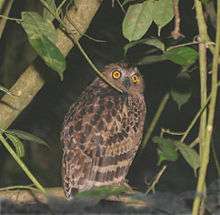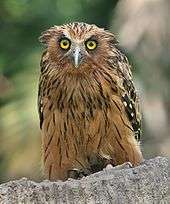Buffy fish owl
| Buffy fish owl | |
|---|---|
 | |
| Scientific classification | |
| Kingdom: | Animalia |
| Phylum: | Chordata |
| Class: | Aves |
| Order: | Strigiformes |
| Family: | Strigidae |
| Genus: | Ketupa |
| Species: | K. ketupu |
| Binomial name | |
| Ketupa ketupu (Horsfield, 1821) | |
| Synonyms | |
|
Ketupa ketupu | |
The buffy fish owl (Ketupa ketupu), also known as the Malay fish owl, is a species of owl in the family Strigidae.
The four fish owls were previously generally separated in the genus Bubo they also resemble osteologically very much – for sake of convenience. Depending on whether some little-studied tropical eagle-owls are closer to the fish-owls than to the typical eagle-owls, Ketupa might be a valid genus if these as well as the fishing owls (formerly Scotopelia) are included in it, although there are a number of osteological differences that suggest that fishing and fish owls are not directly related to each other.[2]
Distribution and habitat
It occurs from central India and southern Burma to the south and east to Cambodia, Laos and Vietnam, peninsular Thailand, the Malay Peninsula, the Riau Archipelago, Sumatra, papua new guinea, Brunei, Cocos (Keeling) Islands, Indonesia to Java, Bali and Borneo. One specimen was recorded at Cocos (Keeling) Island off Australia, 1,050 km (650 mi) outside the species's regular range. Its natural habitat is wet tropical forests and other woody areas near water, including wooded banks of rivers, lakes, fish ponds and rice paddies. It can survive well close to human habitations but can also be found in desolate mangrove forests and other less-inhabited or uninhabited areas. It mainly lives in lowlands but can be found at up an elevation of 1,600 m (5,200 ft).[3]
Description

The buffy fish owl is a fairly large owl but is the smallest of the four species of fish owl. In total length, this species can range from 38 to 48 cm (15 to 19 in). Body mass can range from 1,028 to 2,100 g (2.266 to 4.630 lb), with an average weight of 1,224 g (2.698 lb). This species is yellowish-brown overall, with considerable variegating with pale buff. The feathers are edged tawny and the wings and tail are broadly barred yellowish and dark brown. The wings are distinctly rounded in shape when this species is seen in flight. The underparts are a yellow-brown, rich buff or fulvous color with broad blackish shaft-stripes. The legs are long and unfeathered. This species slightly overlaps in range with the brown fish owl, but that species is slightly larger and considerably more brown in overall color with stronger barring and vermiculations below. The tawny fish owl may also marginally overlap with the buffy fish owl in range and is also larger with a much richer tawny color with a more barred tail, a whiter face and about two-thirds of its tarsi feathered. Like all fish owls, the buffy fish owl has prominent ear tufts but they hang to the sides of the head rather than sit atop and are scraggly looking. This species has been attributed with a range of vocalizations. Among these recorded have included hissing sounds and a rattling kutook, repeatedly rapidly about seven times. Also recorded has been a ringing, loud pof-pof-pof and a high, hawk-like hie-e-e-e-e-keek series of notes. The buffy fish owl is rather noisy before breeding and pairs may engage in bouts of duetting for several minutes at a time.[3]
Compared to eagle owls of similar length, fish owls tend to be even shorter in tail length and even heavier in build, have relatively larger wings (the tawny and Blakiston's being particularly chunky in shape), have considerably longer legs, and have a rough texture to the bottom of their toes. At least the latter two features are clear adaptations to aid these owls in capturing fish. Diurnal raptors who feed largely on fish have similar, if not identical, rough texture under their toes, which helps these birds grasp slippery fish. Unlike diurnal raptors who capture fish such as the osprey (Pandion haliaetus) as compared to most terrestrial raptors, the fish owls have large, powerful, and curved talons and a longitudinal sharp keel sitting under the middle claw with all having sharp cutting edges that are very much like those of eagle owls. Also, unlike fish-eating diurnal raptors will not submerge any part of their body while hunting, preferring only to put their feet into the water, although fish owls will hunt on foot, wading into the shallows. Unlike most owls, the feathers of fish owls are not soft to the touch and they lack the comb and hair-like fringes to the primaries, which allow other owls to fly silently in order to ambush their prey. Due to the lack of these feather-specializations, fish owl wing beats make sounds. The lack of a deep facial disc in fish owls is another indication of the unimportance of sound relative to vision in these owls, as facial disc depth (as well as inner ear size) are directly related to how important sound is to an owl's hunting behavior. Also different from most any other kind of owl, the bill is placed on the face between the eyes rather below it, which is said to impart this fish owl with a "remarkably morose and sinister expression". Similar adaptations, such as unwillingness to submerge beyond their legs and lack of sound-muffling feathers are also seen in the African fishing owls, which do not seem to be directly related. Due to their neat replacement of each other in range, at one time the tawny and buffy fish owls were considered the same species but there are a number of physical, anatomical, habitat and behavioral distinctions between them.[3]
Subspecies
- B. ketupu ketupu (Horsfield, 1821)- Found in the Malay Peninsula, Riau Archipelago, Sumatra, Borneo, Belitung, Java, Bali and much of Borneo. This race matches the description above. It is the only well-studied race and is seemingly the largest, slightly more so than aagaardi and considerably more so than the other two island races. The wing chord is 335 to 390 mm (13.2 to 15.4 in), the tail is 160 to 181 mm (6.3 to 7.1 in), the tarsus is 70 to 80 mm (2.8 to 3.1 in) and the bill is 40 to 42 mm (1.6 to 1.7 in).
- B. ketupu aagaardi (Neumann, 1935)- Found in southern Burma to peninsular Thailand and Vietnam. This race is similar to the nominate but is much paler, especially on the underparts. The wing chord is 315 to 354 mm (12.4 to 13.9 in), other than that it is of the same size as the nominate in linear dimensions.
- B. ketupu pageli (Neumann, 1936)- Endemic to Sarawak on the east coast of northern Borneo. This race is similar to the nominate but is smaller and far more reddish in color, with some birds being a brick-red color. The wing chord is 310 to 330 mm (12 to 13 in).
- B. ketupu minor (Buttikofer, 1896)- Found only on the island of Nias. This race is notably for its very small size. The wing chord is 295 to 300 mm (11.6 to 11.8 in).[3][4]
Ecology and behavior
During the daytime, these owls shelter, often singly, in quite dark places, such as densely foliaged trees. Buffy fish owls are easily disturbed, quite the opposite of the highly stoic tawny fish owl, often being wide-awake before being spotted by a human observer. The largest part of its diet appears to consist of fish, crabs and frogs followed by reptiles, toads and crayfish. Their diet is not extensively studied but appears to be basically the same as those of the brown and tawny fish owls. Rats, mice and large insects are also sometimes taken and even bats have been captured by this species. A small handful of prey has been identified to genera or species in Java: goldfish (Carassius auratus), the gold-ringed cat snake (Boiga dendrophila), puff-faced water snake (Homalopsis buccata), young false gharials (Tomistoma schlegelii), fruit bats (Cynopterus ssp.), centipedes (Scolopendra ssp.), black rats (Rattus rattus) and red junglefowl (Gallus gallus bankiva), some of this prey such as the cat snake and junglefowl being of a fairly large size.[5] Like the brown fish owl but unlike most owls, this species has been recorded consuming carrion, including the remains of a crocodile and a Sunda stink badger (Mydaus javanensis). The buffy fish owl does not produce firm pellets as do most owls. Instead bones and frog and insect remains are ejected in pieces and fall to the ground below roost. Prey remains have only been found within the nest, never around or below the nest as is commonly recorded in other owls. The buffy fish owl hunts mainly from the bank, swooping down much in the manner of a fish eagle but never getting its feathers wet. It also walks into shallow streams and brooks, additionally snatching their main foods in such locations.[3]
Eggs have mainly been found in February through April, less commonly into May through July, as in western Java, and even in September through January in the Malay Peninsula. The buffy fish owl frequently nest on top of a large fern (Asplenium nidus), but nests have also been recorded in the fork a tall bough covered in ferns and moss, on orchid beds and in tree holes. More rarely, rocky sites have been used as nesting sites, even behind waterfalls. The nest is usually merely a scrap into the surface of a fern with no structure or lining, as owls do not build nests. Abandoned bird nests built by other species have been used, including those of brahminy kites (Haliastur indus). Only one egg has ever been recorded in a buffy fish owl nest, giving them the smallest clutch size of any owl alongside the spot-bellied eagle owl (B. nipalensis) and the barred eagle owl (B. sumatranus), which also have only ever been recorded with a single-egg clutch. The egg is round, oval and dull white. The average dimensions of eggs in western Java was 57.4 mm × 47 mm (2.26 in × 1.85 in). Incubation of the eggs lasts 28–29 days and fledgling occurs after six weeks. This species is generally faring well for a large raptorial bird and has been inadvertently aided by commercial fisheries and ornamental ponds, which they visit by night to hunt. Sometimes, they incure persecution from owners of such ponds for taking stock.[3][6]
| Wikimedia Commons has media related to Ketupa ketupu. |
References
- ↑ BirdLife International (2012). "Ketupa ketupu". IUCN Red List of Threatened Species. Version 2013.2. International Union for Conservation of Nature. Retrieved 26 November 2013.
- ↑ Mourer-Chauviré & Weesie (1986), Olsen et al. (2002), Mlíkovský (2002, 2003), BLI (2009)
- 1 2 3 4 5 6 König, Claus; Weick, Friedhelm (2008). Owls of the World (2nd ed.). London: Christopher Helm. ISBN 9781408108840.
- ↑ Weick, F. (2007). Owls (Strigiformes): annotated and illustrated checklist. Springer.
- ↑ Sody, H. J. V. (1989). b. DIETS OF JAVANESE BIRDS. Henri Jacob Victor Sody (1892-1959): His Life and Work: a Biographical and Bibliographical Study, 164.
- ↑ Owls of the World: A Photographic Guide by Mikkola, H. Firefly Books (2012), ISBN 9781770851368
